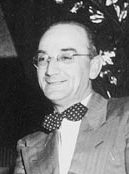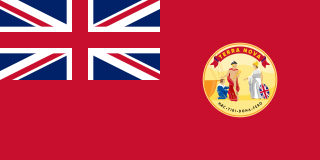
Joseph Roberts Smallwood was a Newfoundlander and Canadian politician. He was the main force who brought the Dominion of Newfoundland into Canadian Confederation in 1949, becoming the first premier of Newfoundland, serving until 1972. As premier, he vigorously promoted economic development, championed the welfare state, and emphasized modernization of education and transportation. The results of his efforts to promote industrialization were mixed, with the most favourable results in hydroelectricity, iron mining and paper mills.
The Liberal Party of Newfoundland and Labrador is a political party in the province of Newfoundland and Labrador, Canada. The party is the provincial branch, and affiliate of the federal Liberal Party of Canada. It has served as the Government of Newfoundland and Labrador since December 14, 2015. The NL Liberals were re-elected to a majority government in the 2021 provincial election.

The Progressive Conservative Party of Newfoundland and Labrador is a provincial political party in Newfoundland and Labrador, Canada. The party was founded in 1949 and most recently formed the Government of Newfoundland and Labrador from the 2003 general election until the 2015 general election. The party has served as the official opposition to the government of Newfoundland and Labrador since 14 December 2015. On October 14, 2023, MHA Tony Wakeham was elected leader.
Thomas "Tom" Gerald Rideout is a former Canadian politician who served as the fourth premier of Newfoundland from March 22, 1989 to May 5, 1989.
Alfred Brian Peckford is a Canadian politician who served as the third premier of Newfoundland from March 26, 1979 to March 22, 1989. A member of the Progressive Conservative (PC) Party, Peckford was first elected as the Member of the House of Assembly (MHA) for Green Bay following the 1972 general election. He served as a cabinet minister in Frank Moores' government before he was elected as PC leader in 1979 following Moores' retirement.

John Carnell Crosbie, was a Canadian provincial and federal politician who served as the 12th lieutenant governor of Newfoundland and Labrador, Canada. Prior to being lieutenant governor, he served as a provincial cabinet minister under Premiers Joey Smallwood and Frank Moores as well as a federal cabinet minister during the Progressive Conservative (PC) governments of Joe Clark and Brian Mulroney. Crosbie held several federal cabinet posts, including minister of finance, minister of justice, minister of transport, minister of international trade, and minister of fisheries and oceans.
Edward Moxon Roberts was a Canadian lawyer and politician. He first served as a member of the Newfoundland and Labrador House of Assembly (MHA) from 1966 to 1985 representing White Bay North, and again from 1992 to 1996 representing Naskaupi. He went on to serve as the eleventh lieutenant governor of Newfoundland and Labrador from 2002 until 2008.

Newfoundland was a British dominion in eastern North America, today the modern Canadian province of Newfoundland and Labrador. It was confirmed by the Balfour Declaration of 1926 and the Statute of Westminster of 1931. It included the island of Newfoundland, and Labrador on the continental mainland. Newfoundland was one of the original dominions within the meaning of the Balfour Declaration, and accordingly enjoyed a constitutional status equivalent to the other dominions of the time.
The Responsible Government League was a political movement in the Dominion of Newfoundland.
Several political groupings functioned in the Dominion of Newfoundland under the name Liberal Party of Newfoundland from the granting of responsible government to the island in the 1850s until its suspension in 1934 when the Commission of Government was instituted. During that period, Newfoundland was an independent dominion within the British Empire, responsible for its own internal affairs.
The United Newfoundland Party was the name of two conservative parties in Newfoundland.

The Newfoundland National Convention of 1946 to 1948 was a forum established to decide the constitutional future of Newfoundland.
Newfoundland, as a British colony and dominion, held 29 general elections for its 28 Newfoundland House of Assemblies; the results of the second election in 1836 were set aside, and another election held in 1837.
The Confederate Association was a political party formed and led by Joey Smallwood and Gordon Bradley to advocate that the Dominion of Newfoundland join the Canadian Confederation. The party was formed on February 21, 1948, prior to the launch of the 1948 Newfoundland referendums on Confederation. The party was opposed by the Responsible Government League led by Peter Cashin and the Party for Economic Union with the United States led by Chesley A. Crosbie.
Chesley Arthur "Ches" Crosbie was a Newfoundland businessman and politician.

The Economic Union Party was a political party formed in the Dominion of Newfoundland on 20 March 1948, during the first referendum campaign on the future of the country. The British-appointed Commission of Government had administered the country since the financial collapse of 1934. The alternatives were "responsible government", or "Confederation".

The Newfoundland referendums of 1948 were a series of two referendums to decide the political future of the Dominion of Newfoundland. Before the referendums, Newfoundland was in debt and went through several delegations to determine whether the country would join Canada, remain under British rule or regain independence. The voting for the referendums occurred on June 3 and July 22, 1948. The eventual result was for Newfoundland to enter into Confederation, which it did on March 31, 1949, becoming the tenth province of Canada.

The province of Newfoundland and Labrador covers the period from habitation by Archaic peoples thousands of years ago to the present day.

The 1949 Newfoundland general election was held on 27 May 1949 to elect members of the 29th General Assembly of Newfoundland. It was the first general election held since Newfoundland joined Canadian confederation on 31 March 1949 and the first Newfoundland-wide election of any kind since the suspension of responsible government and the creation of the Commission of Government in 1934. The election was won by the Liberal Party.












